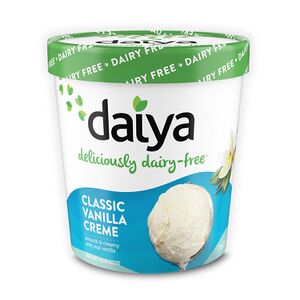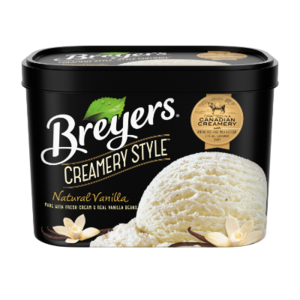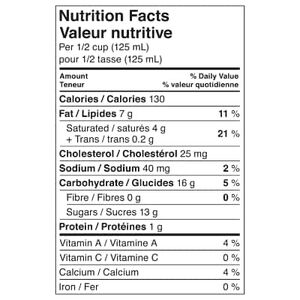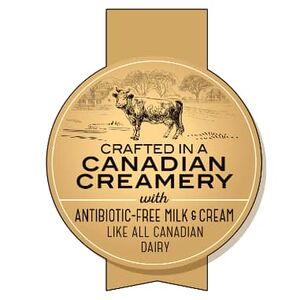Course:FNH200/Assignments/2020/Daiya icecream
Team members: Lia, Leanne, Justine, Jhemma, Ruby.
We have decided to compare vegan and ordinary (dairy) ice creams.
Food Introduction
For this project, we decided to compare ice cream. We all enjoy ice cream, but we wanted to know how different a dairy free vs a dairy ice cream would be in terms of fat and sugar substitutes, additives, and nutrients. We picked the vegan Daiya Classic Vanilla Creme ice cream and the Breyers Natural Vanilla ice cream to compare. The main difference between between the two products is that Daiya is a dairy-free alternative and the Breyers ice cream contains dairy. They are both Vanilla flavoured; therefore, have some similar ingredients. In addition, Daiya is a Canadian-based company that originated right here in Vancouver, BC in 2008.[1]






Ingredient lists
Lists of ingredients:
Daiya Classic Vanilla Creme: water, coconut cream, coconut oil, cane sugar, tapioca syrup, chicory root fiber, fava bean protein, tamarind seed gum, vegan natural flavors, sea salt, locust bean gum, fruit and/or vegetable juice color, vanilla extract. Contains: coconut.
Breyers Natural Vanilla: fresh cream, modified milk ingredients, sugar, condensed skim milk and/or skim milk powder, glucose, natural vanilla flavour, mono and diglycerides, vegetable gums (guar, carob bean), natural colour. Contains: milk. May contain: peanuts and tree nuts.
Identify fat substitutes, sugar substitutes, and/or additives used:[2]
| Breyers Ice Cream | Daiya Ice Cream | |
|---|---|---|
| Additives: |
Mono + Diglycerides
Guar gum + Carob bean gum
|
Locust Bean Gum + Tamarind Bean Gum
Chicory Root
|
|
Fat Substitutes |
Modified Milk Ingredients
|
Tapioca Syrup
|
|
Sugar Substitutes |
N/A |
Tapioca Syrup |
3. Explain the roles of fat substitutes, sugar substitutes, and/or additives used in terms of the functional properties they contribute to the product
Breyers Vanilla Ice Cream
Fat substitutes
Modified milk ingredients (Simplesse): a fat substitute that is based on soy, milk or egg white protein. It helps stabilize food as well as provide texture. The small protein particles in Simplesse are what contributes to the similar creaminess and rich taste of fat in ice cream.
Additives
Guar gum: One of guar gum’s main properties is that it is able to form hydrogen bonds with water molecules[3]. This makes it a suitable additive in frozen applications like ice cream[4]. Its primary function in ice cream is stabilization as well as improvement in texture and chewiness.
Carob bean gum: Similar to guar gum, carob bean gum is another popular stabilizer in ice cream because of its ability to bind with water. It improves ice cream by reducing the size of ice-crystal growth, slows down melting, and provides a creamy and smooth mouthfeel.
Mono and diglycerides: They are emulsifers that help mix oil and water together. Their molecular structure is what helps achieve this: the hydrocarbon tail interacts with other fat-based ingredients and yet is drawn to water by the glycerol end. This helps improve texture and produce a smooth consistency in ice cream.
Daiya Vanilla Ice Cream
Fat substitutes
Tapioca syrup (Maltodextrin): a carbohydrate based fat substitute. It improves the texture of ice cream by enhancing smoothness and imitating fat’s mouthfeel.
Sugar substitute
Tapioca syrup: This is also considered a low calorie sweetener. Tapioca syrup is produced by a fermentation process from tapioca starch and is a good alternative to corn syrup because it produces similar sweetness.
Additives
Chicory root (inulin): A sweetener that provides a similar sweetness profile as that of table sugar making it a suitable low calorie sugar alternative.
Locust bean gum and tamarind seed gums: Both provide a thickening gel effect in ice cream. They are stabilizers in ice cream because of their properties that bind to water. Tamarind seed gum is a stabilizing agent of ice crystals. It forms fine ice crystals to contribute to the smooth texture of ice cream. Chicory root serves the same purpose and improves by contributing to the creamy and fat-like mouthfeel.
4. Compare and contrast the lists of the two products and explain differences
The ingredient lists of our two products are extremely different, because they are intended for different dietary needs. The Daiya ice cream is made for a vegan diet, whilst the Breyers has been crafted for a diet that includes dairy. Therefore, many differences can be found between the two products. However, because both companies are aiming to have the typical 'ice cream' texture, as well as a sweet vanilla taste, there are similarities in the ingredients as well.
The biggest difference is that Daiya uses water and coconut cream as the base for their ice cream, whilst Breyers uses regular cream. This difference is due to the vegan/dairy needs of their consumers. In terms of fats, Breyers uses modified milk ingredients, which is another name for Simplesse, as a low calorie fat alternative. By contrast, Daiya uses coconut oil, a natural and saturated fat. Again, this difference can be accounted to Daiya wanting to stay away from non-vegan as well as non-processed ingredients. In addition, the Daiya product uses chicory root fiber, fava bean protein, vegan natural flavours, salt, and fruit/vegetable juice colour. This assortment of ingredients demonstrates that Daiya is invested in using natural ingredients whenever possible, and is likely using the chicory root fiber and fava bean protein to increase the nutritional value of the ice cream. Breyers uses condensed skim milk, skim milk powder, mono and di-glycerides, and natural colour. The forms of skim milk are obviously non-vegan, and are used to sweeten and thicken the recipe, whilst the glycerides are used as emulsifiers to help the oil and water to blend. In contrast to the Daiya ice cream, Breyers is using non-vegan, more processed ingredients to produce their ice cream.
On the other hand, there are also similarities between the two dessert products. Both contain sugars, vanilla flavouring, and vegetable gums. The Daiya product uses cane sugar and tapioca syrup (another form of High Fructose Corn Syrup) to sweeten the ice cream. Breyers uses sugar and glucose (a monosaccharide sugar substitute) instead. Both contain vanilla flavouring, which adds to the vanilla aspect of their respective products. Finally, Daiya uses tamarind seed gum and locust bean gum to thicken and stabilize their product, whilst Breyers uses guar and carob bean gums for the same purpose. Although the two products have many differences, they both use sweetening agents, thickening gums and vanilla flavouring to help the texture and taste of their products.
Labels
| Requirements | Breyers Natural Vanilla Ice Cream | Daiya Dairy-Free Ice Cream |
|---|---|---|
| Bilingual labelling | Mandatory information such as the ingredients list and product description is in both Canadian official languages (i.e. English and French) | Mandatory information such as the ingredients list and product description is in both Canadian official languages (i.e. English and French) |
| Common name | Ice Cream | Ice Cream |
| Country of origin | Manufactured in Canada | Manufactured in Canada |
| Storage life/Durable life: |
|
|
| Identity/Principal Place of Business: | Good Humor-Breyers: 175 Union St, Simcoe, ON. Canada N3Y 2B1 | Daiya Foods, INC.: Vancouver, B.C. Canada V5M 3T7 |
| Irradiated Foods: | Not applicable to ice-cream | Not applicable to ice-cream |
| Legibility/Location: |
|
|
| List of Ingredients: | Indicated above in descending order by weight. | Indicated above in descending order by weight. |
| Nutrition Facts: | Nutrition facts are listed per ½ cup in a serving. The facts indicate the total calories, fat (saturated and trans), cholesterol, sodium, total carbohydrates and protein per serving. Amounts of Vitamin A and C, Iron, Calcium and Potassium are listed at the bottom. | Nutrition facts are listed per ⅔ cup in a serving. The facts indicate the total calories, fat (saturated and trans), cholesterol, sodium, total carbohydrates and protein per serving. Amounts of Vitamin D, Iron, Calcium and Potassium are listed at the bottom. |
| Net Quantity: | 1.66 L | 473 mL |
| Sweeteners: | There is no mention of the product being sugar-free/no sugar added on the labels of both items.
Breyer’s “Natural Vanilla with Vanilla Beans” label suggests to the consumer that the sweetness is derived from less processing compared to the Daiya dessert. Ingredients list indicates that it contains glucose. |
There is no mention of the product being sugar-free/no sugar added on the labels of both items.
Ingredients list indicates that it contains cane sugar. |
| Nutrient Content Claims: | The packaging contains labels which market their use of Canadian dairy and their use of supporting local farms. The ice cream is also gluten-free.
Examples include Image 1/1.1/1.2. |
The Daiya ice cream is only marketed as being deliciously dairy-free and has no other health-related content claims such as being fat-free/light. |


Indicate whether the information complies with the regulatory requirements as outlined in Lesson 04.
The Daiya dairy free vanilla ice cream and Breyers vanilla ice cream, to my knowledge, complies with the regulatory requirements that were explored in lesson 4.
- Health Canada outlines the food regulations regarding the identity and composition of foods and food additive regulations. Identity standard defines the different ingredients in a food and “unstandardized foods” do not have a standard of identity. Daiya Vanilla ice cream and Breyers Vanilla ice cream does not contain any “unstandardized” ingredients. Compositional standards list the permitted ingredients in food item. Because dairy free ice cream is a new trend, I do not believe there is a specific compositional standards regulations requirement list for Daiya Vanilla ice cream, but for the Breyers Vanilla ice cream, the is a specific composition list, which Breyers does comply to. Health Canada also contains food additive regulations. Division 16 of the Food and Drug Regulations outlines the name and purpose of different additives and also gives us the foods they are allowed to be in and the maximum amount permitted. If a food is not in the additives section, it is not allowed to be in it at all. Daiya Vanilla Ice cream and Breyers Vanilla ice cream follows all these rules.
- The Canadian Food Inspection Agency, among other roles, plays a part in food labeling. Both Daiya and Breyers vanilla ice cream contain all the requirements the CFIA outlines that are needed in all foods. This includes the bilingual label, common name of the food, date marking and storage instructions, durable life, identity and principle place of business, irradiated foods, legibility and location, list of ingredients, nutrition facts table, net quality of the food, sweeteners and diet related health claims. Both of the items we are comparing contain these notices on the products. The CFIA also administers Food grades. Breyers follows all food grade regulations via the dairy products food grade requirements, but as of right now, there are no food grade requirements for dairy free ice cream, such as Daiya.
- Measurement Canada regulates weights and measures standards. This process happens in the process from factory to shelf and is regulated by certified measuring devices that are not available to public knowledge.
- British Columbia Ministry of Health and Municipal makes sure retail stores, food service establishments and other processing plants are obtaining to the rules and regulations of health and safety. This is also not available for public viewing.
References
Please use the Wikipedia reference style. Provide a citation for every sentence, statement, thought, or bit of data not your own, giving the author, year, AND page.
Note: Before writing your wiki article on the UBC Wiki, it may be helpful to review the tips in Wikipedia: Writing better articles.[5]
- ↑ "Daiya Foods".
- ↑ "Lists of Permitted Food Additives".
- ↑ Mudgil, Deepak (2011-10-04). "Guar gum: processing, properties and food applications—A Review". Food Science and Technology.
- ↑ "Division 16, Table IV: Food Additives That May Be Used as Emulsifying, Gelling, Stabilizing and Thickening Agents". Justice Laws. 2019-12-16. Retrieved 2020-07-21.
- ↑ En.wikipedia.org. (2018). Writing better articles. [online] Available at: https://en.wikipedia.org/wiki/Wikipedia:Writing_better_articles [Accessed 18 Jan. 2018].
| This Food Science resource was created by Course:FNH200. |
